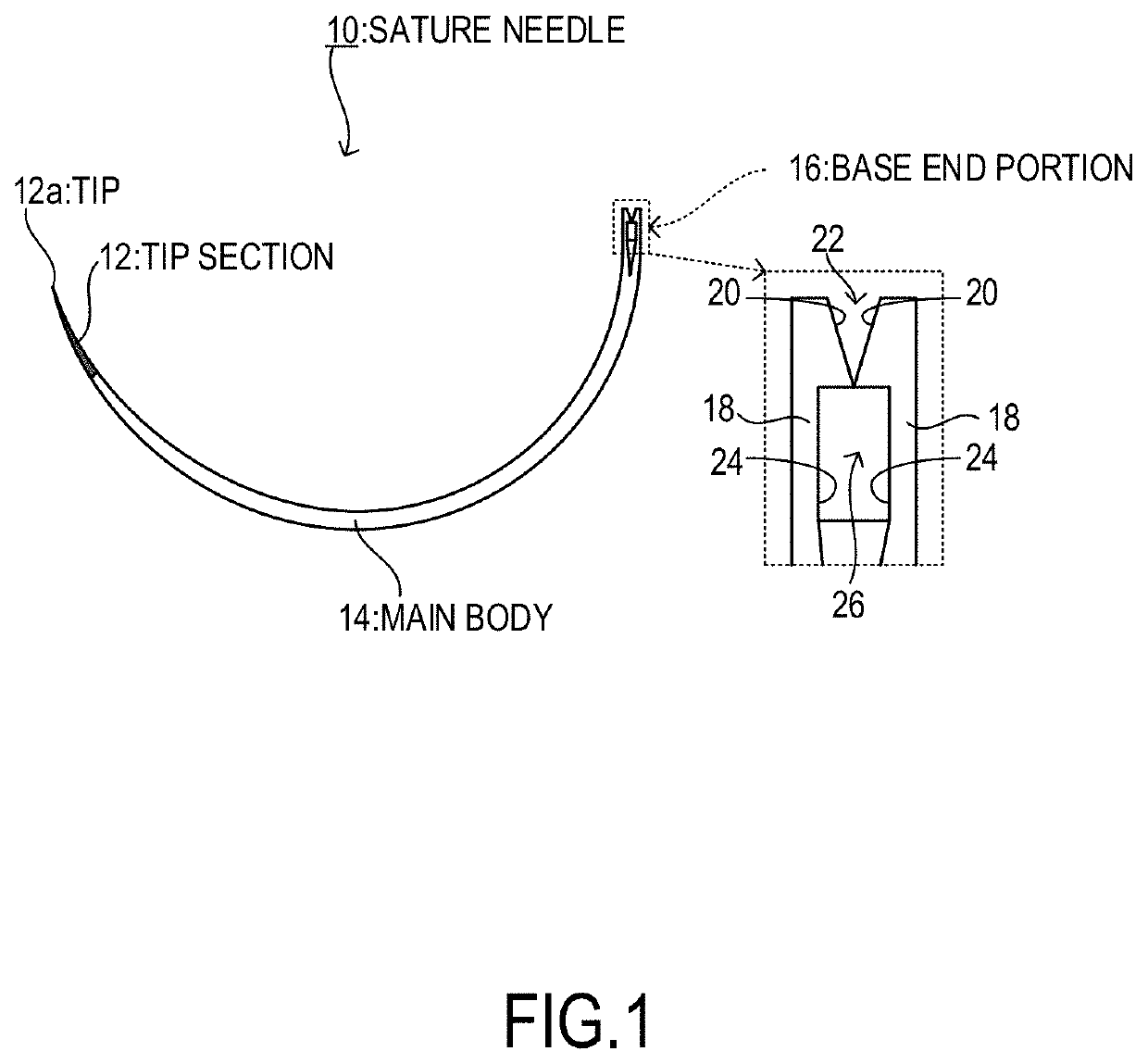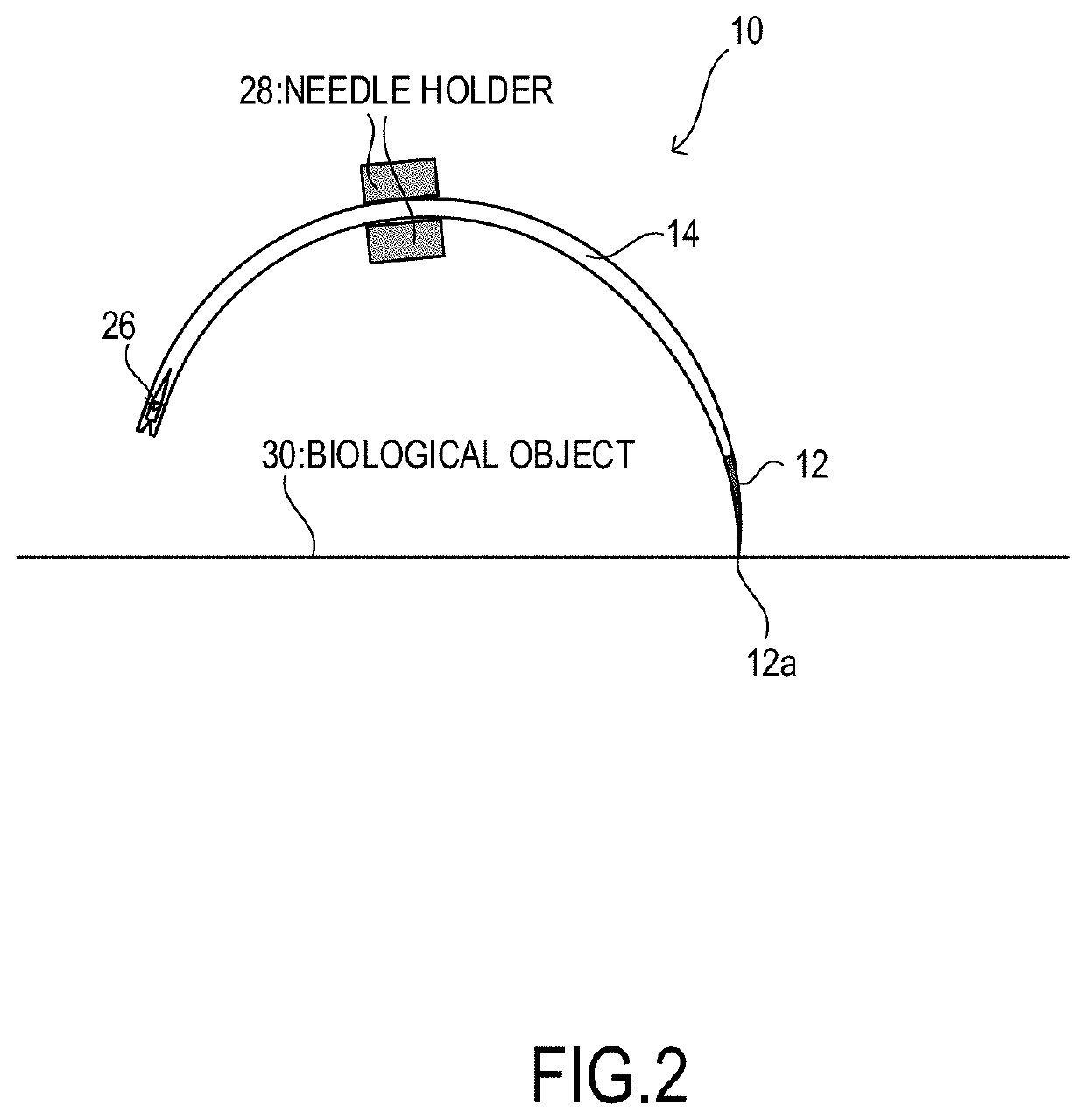Suture needle
a needle and suture technology, applied in the field of suture needles, can solve the problems of erroneously grasping the tip section, the tip section may be subjected to a load, etc., and achieve the effect of low distinguishability as a mark
- Summary
- Abstract
- Description
- Claims
- Application Information
AI Technical Summary
Benefits of technology
Problems solved by technology
Method used
Image
Examples
first embodiment
[0017]FIG. 1 illustrates a schematic diagram of a suture needle of a first embodiment and a partially enlarged view thereof. A surgical suture needle 10 of this embodiment uses, for example, stainless steel as a material, and has an outer shape curved into an approximately semicircle. The suture needle 10 is configured of a tip section 12, a main body 14, and a base end portion 16. Cross-sectional shapes of the tip section 12, the main body 14, and the base end portion 16 are not particularly limited, and, for example, a circular shape and a polygon shape, such as a triangular shape, are applicable. This cross-sectional shape can be designed to change as moving in a longitudinal direction of the suture needle 10. It should be noted that the suture needle 10 has a portion up to approximately ⅓ of the length of the suture needle 10 including the tip section 12, and the portion serves as an edge that pierces into a biological object 30 (see FIG. 2).
[0018]The tip section 12 is a portion...
second embodiment
[0034]FIG. 8 is a partially enlarged view of the suture needle in a second embodiment. As illustrated in FIG. 8, a suture needle 10A according to the second embodiment has an outer shape in common with the suture needle 10 of the first embodiment. The tip section 12 has a tip region 12b from the tip 12a of the suture needle 10A to a midpoint in the longitudinal direction of the tip section 12. The tip region 12b is colored in a color different from a color of a portion other than that (tip region 12b) of the tip section 12. In particular, the tip region 12b is preferred to be colored in black, or may be colored in white, gold, and silver, other than black.
[0035]Thus, coloring the tip region 12b in a color different from a color of another portion of the tip section 12 causes the doctor to visually recognize a presence of the tip 12a that exposes again from the biological object 30 after piercing the suture needle 10 into the biological object 30 (not illustrated in FIG. 8), thereby ...
third embodiment
[0036]FIG. 9 is a partially enlarged view of a suture needle of a third embodiment. As illustrated in FIG. 9, a suture needle 10B of the third embodiment has an outer shape in common with the suture needle 10 of the first embodiment. The tip region 12b from the tip 12a of the suture needle 10 to the midpoint in the longitudinal direction of the tip section 12 in the tip section 12 is not colored. The tip region 12b is in a state where a surface of the suture needle 10 is exposed and is a portion where a color (for example, silver or brown) of a material of the suture needle 10 appears.
[0037]Thus, not coloring the tip region 12b causes the doctor to visually recognize a presence of the tip 12a exposed again from the biological object 30 after piercing the suture needle 10 into the biological object 30 (not illustrated in FIG. 9), thereby ensuring the enhanced operation efficiency of suturing.
[0038]In the second embodiment and the third embodiment, a ratio of the length of the tip reg...
PUM
 Login to view more
Login to view more Abstract
Description
Claims
Application Information
 Login to view more
Login to view more - R&D Engineer
- R&D Manager
- IP Professional
- Industry Leading Data Capabilities
- Powerful AI technology
- Patent DNA Extraction
Browse by: Latest US Patents, China's latest patents, Technical Efficacy Thesaurus, Application Domain, Technology Topic.
© 2024 PatSnap. All rights reserved.Legal|Privacy policy|Modern Slavery Act Transparency Statement|Sitemap



